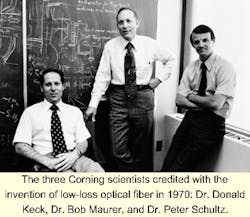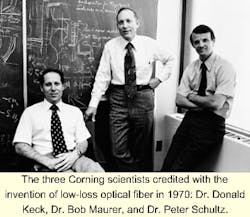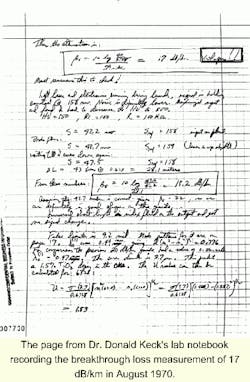Optical fiber spans 30 years
It took four years to achieve the technical breakthrough that led to today's multibillion-dollar optical-fiber-based communications industry.
Dr. Donald B. Keck
Corning Inc.
When Dr. Bob Maurer, Dr. Peter Schultz, and I set forth in the mid-1960s to make optical fiber a practical reality, little did we know that our work would revolutionize the way the world communicates and spawn a $60-billion industry.
Today, millions of these optical fibers continue to revolutionize communications. Each capable of carrying more than 10 Gbits/sec of data, voice, or Internet traffic; enough bandwidth to transmit the entire 30-volume Encyclopedia Britannica from New York to California. Optical fiber has made the global Internet a reality. Today, it carries virtually all of the long-distance telephone calls in the United States and in much of the developed world.
In the 30 years since our invention of low-loss fiber, more than 300 million km of optical fiber have been deployed worldwide. That much fiber alone can handle more information than all the billions of kilometers of copper wiring installed over the past century. It would take 2 metric tons of copper wire to transmit the information handled by a little more than 1 lb of fiber. In labs today, a single fiber can transmit the equivalent of 60 million simultaneous telephone calls.Since the low-loss breakthrough in a Corning lab in 1970, which made fiber practical for communications, the global optical information industry has grown into a $1.5-trillion business, according to the Optoelectronics Industry Development Association, with revenue increasing at twice the rate of the world economy.
In the mid-'60s, before the development of low-loss optical fiber, engineers were seeking more transmission bandwidth, much as they are today. The number of telephone calls was increasing dramatically and carriers recognized that the state-of-the-art copper cables would be strained to capacity in the near-term. There was a need for a new kind of telephone wire to provide greater capacity in less space. This demand stimulated an intense international effort to find a solution to leapfrog copper's limitations.
Radio and microwave frequencies were in heavy use, and some researchers pursued higher frequencies to carry the additional traffic, which was expected to grow as television and telephone usage increased.
But a few companies, Corning among them, believed optical fiber offered potential for telecommunications use. The challenge was to find a way to prevent light from fading or being lost as it traveled along the length of fiber. The goal was to demonstrate a fiber with a loss of no more than 20 dB/km.
Bob worked on the physics of the problem. Peter, a chemist, developed the glass formulations. Together, Peter and I would draw the glass into fiber. My role was then to measure the fiber's transmission properties. I remember the early demonstrations indicating losses in the thousands of decibels. We had our work cut out for us, but the goal was clear.The fiber needed to be constructed from two layers of glass-a core to carry the light and a cladding to contain the light by causing it to reflect internally. The breakthrough would ultimately be the development of the core-a glass that would allow light to travel through a kilometer. At the time, the purest glass in the world was fused silica, a glass developed at Corning by Dr. Frank Hyde. But its high melting temperatures didn't make it seem like an obvious candidate material for optical fiber.
While our competitors were seeking to remove impurities from optical glasses, we took the opposite approach. We focused on the development of the cladding and made the decision to use fused silica for both the cladding and core but added controlled impurities to the core to make its refractive index higher than the cladding.
At the same time, we faced the challenge of actually making the glass into fiber. Here again, we pursued a contrary approach. The cladding needed to be thicker than the core to provide the reflectance, therefore, we had to think "out of the box" to develop a bubble-free process so light couldn't escape from tiny air holes. We deposited a thin film of core glass using Corning's vapor deposition technology inside a thick-walled tube of cladding glass. Hence, the process of vapor deposition, invented by Dr. Frank Hyde for use in other Corning technologies became part of the fiber-making process.
After almost four years of trial and error, experiment, and learning, the breakthrough ultimately came early one evening in August 1970, when the measurements indicated that we had achieved a loss of less than 20 dB/km. This low-loss fiber could potentially transmit 65,000 times as much information as copper wire.
But in 1970, optical fiber was ahead of its time. It took almost 13 years to progress from the initial invention to the first large commercial order. That breakthrough came in 1982, when the government deregulated the telecommunications industry, allowing entrepreneurial companies to challenge the existing technologies and embrace optical fiber to build new telecom networks.
One of today's largest long-distance carriers in the United States, MCI was the first to build a national telephone network with singlemode optical waveguides. In 1983, MCI asked Corning to supply the optical fiber for the national network. Although by this time Corning had produced enough fiber to wrap twice around the earth's equator, the volume of fiber being requested dwarfed that amount. Fortunately, our research team had worked diligently with Corning's manufacturing organization to develop large-scale, cost-effective production processes. Key developments included advanced optical designs and measurement techniques, advanced glass deposition, high-temperature draw furnaces, and polymer coatings. Corning worked closely with the optical-fiber-cabling companies to advance this growing national fiber system. The first fiber went into long-haul "trunks" between major cities.
By the end of the 1980s, systems movement toward longer operating wavelengths was well underway. Dispersion-shifted fiber (DSF), first introduced in 1985, heralded a new era in optical communications. By wedding the attenuation minimum in the 1,550-nm window with zero dispersion at that operating wavelength, higher data rates could be carried over very long distances.
Until this time, fiber systems were still based on using electronics to regenerate signals. While adequate for the modest data rates then, it was recognized to be more difficult for such technology when progressing to multigi-gabit-per-second rates. Moreover, electrical regeneration was limited to a single wavelength.
In the early 1990s, the erbium-doped fiber am plifier (EDFA) emerged as what many consider to be the second revolution in optical-fiber communication. This technology not only overcame the bit-rate limitation of electronic regeneration and allowed five to 10 times longer spans without the use of repeaters, it enabled WDM to become the dominant transmission methodology that it is today.
As these new technologies were deployed, it became clear that the very attribute that had made dispersion-shifted fiber so attractive rendered it less suitable for the demands of WDM. The extra power that the fiber was required to carry as a result of the many amplified wavelength channels, caused nonlinear transmission effects.
One of the earliest and most troublesome of these effects to emerge was four-wave mixing (FWM). In FWM, multiple wavelengths combine to create new wavelengths that can potentially interfere with transmission. The effect is most pronounced when dispersion is near zero.
The industry's development of nonzero dispersion-shifted fiber (NZDSF) was a direct response to these detrimental nonlinear propagation effects. Shifting the zero-dispersion wavelength outside the operating window, and thereby introducing a small but finite amount of dispersion, can reduce the effects of FWM.
To achieve a reduction in nonlinear effects, the first commercially available NZDSF with large effective area appeared in 1998. By increasing the effective area of the mode field within the fiber, the overall power density, and, thereby, the nonlinear effects, can be reduced. The technical benefits are immediate: higher power-handling capability, greater signal-to-noise ratio, and greater amplifier spacing. While designed for amplifiers in the C-band, this fiber can also accommodate further expansion of channels in the L-band.Even with all this transmission capability, terrestrial long-haul technology and its requirements continue to evolve at an astounding rate. This evolution will require new fiber designs. Many companies, for example, are investigating various forms of dispersion-managed fiber and cable. These new fibers must not dramatically change cabling processes, bending requirements, or splicing technology. At the same time, the design of next-generation fibers must increasingly support interdependency with other components to deliver cost-effective system performance.
In addition to fiber optimized for long-haul applications, there is an increasing need to "couple" the properties of fibers with lasers to meet the unique demands of metropolitan and local-area networks. Here too, one must optimize the combination of fiber and other system components. For example, our recently introduced fiber matches the fiber dispersion characteristics with the pulse dispersion characteristics of directly modulated distributed-feedback lasers. It has been demonstrated that by combining the capability of these lower-cost lasers with this fiber, 2.5-Gbit/sec signals can be transmitted beyond 400 km. This approach reduces network complexity and lowers first-time installation costs by 6%-10%.
Much like erbium amplifiers enabled a significant leap forward in optical-fiber-based communications, it is expected that optical switching and routing will spark yet another revolution. Transparent optical reconfigurability, using wavelength selective crossconnects and wavelength add/drop multiplexers, could potentially lower overall system costs by eliminating unnecessary optical-electrical-optical conversion in networks.
There is intense focus throughout the optical-fiber telecommunications industry to deliver this high-bandwidth, all-optical network. Bandwidth requirements, driven largely by the Internet, are expected to increase 10,000-fold over the next decade (see Figure). Higher bandwidth applications such as high-density television, Web casting, streaming video, and two-dimensional multimedia will fuel this demand. And on the horizon, intelligent applications (Web agents), computer-to-computer applications, and three-dimensional multimedia will require even more bandwidth.
Where will it end? Thirty years ago, it was impossible to predict what today we take for granted. History has clearly demonstrated that as long as scientists and engineers around the globe continue to invent the technology to transmit information at a lower cost per bit, creative people will find a reason to send proportionally more bits. This cycle is the driving force that will ensure a future full of light.
Dr. Donald B. Keck is vice president and technology director of optical physics at Corning (Corning, NY).


